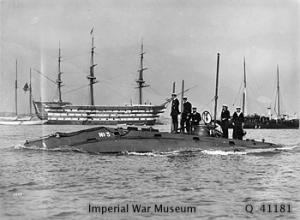HMS Holland 5
50°43′44″N 0°14′53″E / 50.729°N 0.248°E
 A submarine of the Holland class
| |
| History | |
|---|---|
| Name | Holland 5 |
| Ordered | 1900 |
| Builder | Vickers, Sons and Maxim, Barrow |
| Launched | 10 June 1902 |
| Commissioned | 1902 |
| Fate | Foundered off Beachy Head, 8 August 1912 |
| General characteristics | |
| Type | Submarine |
| Displacement | 105 long tons (107 t) (submerged) |
| Length | 63 ft 5 in (19.33 m) |
| Beam | 11 ft 10 in (3.61 m) |
| Draught | 11 ft 10 in (3.61 m) |
| Installed power |
|
| Propulsion |
|
| Speed | 7 kn (8.1 mph; 13 km/h) submerged |
| Range | 20 nmi (23 mi; 37 km) at 7 kn (8.1 mph; 13 km/h) submerged |
| Test depth | 100 ft (30 m) |
| Complement | 8 |
| Armament | 1 × 18 inch (450 mm) torpedo tube (Up to 3 torpedoes ) |
Holland 5 was the last of the five
She had a single-hull design, built from
Damage has been caused to the site in recent years, and at some point between September 2008 and June 2010, the torpedo hatch was stolen off the wreck.
Design and description
Holland 5 was the fifth of the experimental
She was equipped with one of the first
Service history
Along with
On 4 March 1903, she was part of the flotilla of Holland-class submarines that were undergoing a demonstration for Captain
By 1912, the decision was made to scrap the Holland-class vessels.[7] The submarine foundered in the English Channel off Beachy Head, Sussex, on 8 August 1912, when she was under tow on the way to being scrapped at Sheerness.[5] It was not clear why she sank, but a theory is that the torpedo tube hatch was left open, causing the boat to take on water.[10]
Wreck discovery and research
In September 2000,[5] the wreck of submarine Holland 5 was discovered at a depth of 98 ft (30 m) about 6 miles (9.7 km) off the British coast near Eastbourne.[11] In April 2001, the Archaeological Diving Unit conducted a sonar scan and confirmed the identity of the wreck. The boat sits upright on the seabed.[5]
On 4 January 2005,
In 2010, it was discovered that at some point divers had stolen the torpedo tube hatch off the wreck. It was determined that the item would have no monetary value and would have gone into a private collection.[14] There were no official dives on the wreck during 2009 due to the conditions, and the last sighting of the hatch in place was in September 2008.[6] Further damage has been caused to the site by fishing nets, which may have resulted in damage to the periscope and the other implements installed on the upper superstructure.[6]
Holland 5 remains the only submarine of her class on the seabed.
See also
- Archaeology of shipwrecks
- List of designations under the Protection of Wrecks Act
- Maritime archaeology
- Underwater archaeology
References
- ^ "Naval & Military intelligence". The Times. No. 36791. London. 11 June 1902. p. 13.
- ^ a b c d e "Holland Class". Barrow Submariners Association. Archived from the original on 4 October 2015. Retrieved 19 January 2012.
- ^ "The Progress of the Submarine During 1903". The Times. No. 37360. 5 April 1904. p. 8.
- ISBN 978-1-904381-05-1.
- ^ a b c d e f "Holland No.5". English Heritage. Retrieved 19 January 2012.
- ^ a b c d "Holland 5 Submarine". Nautical Archaeology Society. Archived from the original on 2 March 2012. Retrieved 19 January 2012.
- ^ ISBN 978-1-904381-04-4.
- ^ "Explosion on Board a Submarine". The Times. No. 37020. 5 March 1903. p. 9.
- ^ "The Fleet in the Thames". The Times. No. 39014. 17 July 1909. p. 8.
- ^ Pugh, Tom (1 September 2010). "Thieves target historic submarine wreck". The Independent. Retrieved 19 January 2012.
- ^ Mattock, Jo (7 October 2010). "Hatch Stolen from Submarine Wreck". DIVE. Archived from the original on 15 September 2012. Retrieved 19 January 2012.
- ^ "Heritage Minister Andrew McIntosh Acts To Protect Wreck Site Of Prototype Submarine". 4 January 2005. Department for Culture, Media and Sport. Archived from the original on 7 March 2008. Retrieved 19 January 2012.
- ^ "Submarine wreck to be protected". BBC News. 4 January 2005. Retrieved 19 January 2012.
- ^ "Divers steal from Holland 5 submarine off Sussex coast". BBC News. 1 September 2010. Retrieved 19 January 2012.
- ^ Dooley, David. "Species seen on the Holland 5 submarine site". Nautical Archaeology Society. Archived from the original on 7 September 2012. Retrieved 19 January 2012.
- ^ "Time Team Specials – The Lost Submarine of WWI – Channel 4". Channel 4. Retrieved 22 December 2015.
External links
- A report on diving the wreck from the 2006 Heinke trophy winning submission of Totnes SAC
- MaritimeQuest HMS Holland 5 Pages
- A photo of the wreck
- "Holland No. 5" National Heritage List for England
